#In the Old EU the Jedi were shown as being very different in the thousands of years before the Prequels Era
Explore tagged Tumblr posts
Text
I guess ultimately, my issue with the way some people emphasize that the Jedi code works and that the Jedi were doing really good and that they really didn't fail Anakin in any way (or at least not any way that can really lie in their fault), and the way the Order does things in the Prequels era is excellent and good overall is that -
In the Prequels, the Republic is broken. Republics don't collapse out of nowhere. Institutions don't just implode like the Republic's did for no reason. The Republic's fall was the result of generations of complacency, corruption, stultification, ossification, cutting short term deals, overreach, underaction - there's a reason so many people were onboard with the idea of an Empire at first, and it wasn't all just bribery, xenophobia and fear.
And I guess - I just can't accept that the Jedi were just humming along fine this whole time, without also turning inward too much, without also ossifying and becoming complacent. Because the Jedi were too bound up with the Republic for that to not be the case.
#Musings#Star Wars#This isn't hate for the Jedi this is just -#In the Old EU the Jedi were shown as being very different in the thousands of years before the Prequels Era#such that they needed the Ruusan Reformations to explain the change#And the way they had before was honestly pretty good overall - the Reformations were genuinely a mistake IMO#But mistakes get made and the Jedi had good reasons for those choices they made sense at the time#but I just can't look at the Jedi Order as of the Prequels era and see a fully 100% functioning at peak efficiency organization when other#material shows they could have been and *were* different and still did their job fine#I just don't like the idea that the Republic ossified so much and there was nothing similar happening with the Jedi#Kylia Writes a Novel in the tags
7 notes
·
View notes
Text
The problem with Star Wars Rebels
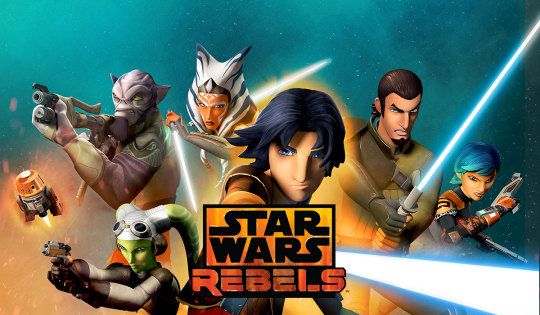
At the behest of several friends and acquaintances I decided to start watching the animated series Star Wars Rebels. I had previously watched The Clone Wars, but eventually gave up on it for a variety of reasons that I may explain in a separate post. I am currently on episode 14 of the second season of Star Wars Rebels, yet I feel I am able at this time to try and pinpoint some of the issues I’ve been having with this series.
Let me preface this by saying Rebels is not a bad show, at least I don’t think so. I think all fans, both old and new, can agree it’s entertaining, there’s a lot of humour, and voice acting is very good. Some might even delight in meeting familiar characters from the Star Wars Universe, like Leia, Lando, or the droids, or learning new bits of lore, such as the origin of the Rebel B-Wing starfighter. I do believe that someone (relatively) new to the Star Wars Universe will find more to enjoy in Star Wars Rebels than an old fan like me, but I am trying and I will keep on trying.
Speaking for myself, I come with a lot of Expanded Universe (EU) baggage, and retcons are not something that I take to lightly, especially when they’re gratuitous or badly done. My head is filled with details that fleshed the Star Wars Universe, details provided by the EU, so when I see something in Star Wars Rebels (and in The Clone Wars too) that overwrites that data an alarm goes off at the back of my head and I’m taken out of the experience even if for a tiny bit. The Clone Wars is perhaps the most egregious culprit as Dave Filoni messed with continuity (LucasArts wasn’t owned by Disney then) resurrecting already-dead characters (e.g.: Darth Maul) and completely altering Mandalorian culture, among others.
However, retconning is only (a small) part of the problem with Star Wars Rebels. I believe there are more basic issues with the series that I’ll do my best to outline in this post. So, without further ado, let’s take a look at what happened a long, long time ago, in a galaxy far, far away.
The origins of the Rebel Alliance... kinda
Star Wars Rebels follows the adventures of a young group of mercenaries turned freedom-fighters 5 years before the Battle of Yavin (BBY). The show starts as a young thief by the name of Ezra bumps into a group, led by Kanan, a former Jedi-turned-mercenary, in the process of stealing supplies from the Empire. These will be our heroes for the remainder of the series. Besides Kanan and Ezra, we have: Zeb, a Lasat male honor guardsman who acts as the muscle; Chopper, an astromech droid that’s in charge of opening every door and repairing everything that doesn’t work properly; Sabine, a Mandalorian who has a penchant for art and blowing stuff up; and Hera, daughter of Cham Syndulla (from TCW), top-notch pilot and sharing the lead together with Kanan.
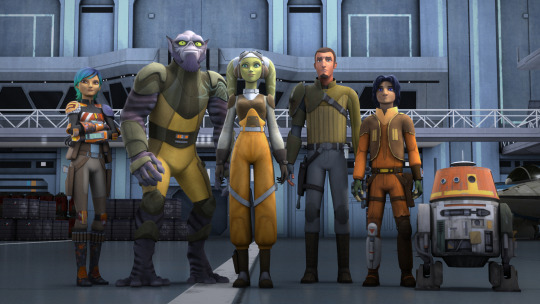
From left to right: Sabine, Zeb, Hera, Kanan, Ezra, and Chopper.
Comparisons with the gang from the Original Trilogy (OT) are self-evident and are not the focus of this post, nor of this particular point. As the show progresses, we come to learn that his group, while operating independently, does strike against the Empire every now and then. Circumstances eventually force them to make a stand, and thus we learn that they were actually operating as a cell, and that there are other Rebel cells operating throughout the galaxy. In short, what we have is a small window into the origins of the Rebel Alliance.
Putting aside the (non-canon and Force-powered) story of The Force Unleashed, which also depicts the origins of the Rebel Alliance (and is incidentally very good at it), one obvious question comes to mind, do we really need this story? Do we need to know exactly how the Rebel Alliance came together to stand against the might of the Empire forged by Emperor Palpatine and Darth Vader? To my mind, the answer is no. History has shown us that rebellion is commonplace in empires that abuse their power and oppress their people. Therefore, that a rebellion would surface in the span between Episodes III and IV doesn’t come as a surprise. Would I want this story to be told though? If executed properly, the answer is yes.
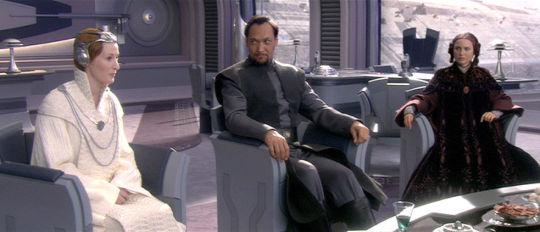
Planting the seeds of rebellion.
George Lucas tried to show us some of this in Episode III with a series of meetings between Bail Organa, Mon Mothma, Padmé Amidala, and a few other senators, where they discussed the future of the Republic and what they might need to do to save it. Unfortunately, those scenes got cut for the theatrical release. Maybe they were a tad too on the nose, maybe Lucas thought it would remind people of The Phantom Menace’s politics. I am perhaps one of the few who finds that politics are an integral part of the tale of the Republic’s downfall and who believes they don’t have to be detrimental to a story. Just look at the excellent The Legend of the Galactic Heroes for reference. Whether you’re a fan of the light novel series by Yoshiki Tanaka, or the (superior) anime version, it’s a story fraught with history, politics, economics, religion, and warfare, that finds the right balance between all these elements. If Star Wars Rebels were to combine these elements half as well to tell us how the Rebel Alliance was formed, it would make for one hell of a story.
Unfortunately, so far Rebels has made no attempt to do so. There are many basic questions that remain unanswered. For instance, if Hera’s (she’s their commanding officer now, right?) band of freedom fighters is just one cell out of many, does that mean that there’s some sort of centralized power structure? The story seems to suggest the rebels were disorganized before Hera’s group rallied them into action but it’s never really clear. At the same time, it also suggests Hera was already taking orders from some form of command authority back in their early ‘independent’ days. Which one is it?
If there is a commanding body to the rebel movement, is there a larger plan beyond ‘sticking it to the Empire’? How exactly are the rebels planning to overthrow the Empire, if indeed that is their goal? Are we even at the point of calling it the Rebel Alliance? It would appear that at least the rebel group working with Hera is mobile and doesn’t have a base of operations. Is this the same for other cells?
My head is filled with dozens of questions that scream (a bit of hyperbole, okay) to be answered, but the show remains oblivious and chooses to plunge through regardless. To be perfectly honest, I doubt the creators themselves know the answers. It is this internal confusion that throws me for a loop. Perhaps they believe these are trifle questions not worth pondering. I beg to differ. If you choose to tell a story about the origins of the Rebel Alliance, thoroughly exploring said origins is a must; at the very least I would expect it to be internally coherent and not sow confusion every two episodes.
This ties neatly into my second point, which is...
The Force is too strong with this one
When old Ben Kenobi tells Luke how the Jedi were once the guardians of peace and justice in the Old Republic, one has the sense that he’s talking about a distant memory, something that happened a long time ago. Indeed, watching the OT, you get the feeling that most of the galaxy believes that the Jedi were nothing but a myth. General Motti went so far as to question Vader’s sad devotion to that ‘ancient religion.’ Tarkin is adamant that Vader’s the only Jedi left. Even though he’d be proven wrong minutes (and an episode) later, the universe of the Classic Trilogy has all but forgotten the Jedi.
When Luke picks up the Jedi mantle it’s an incredibly boon for the Rebel Alliance. Not only have they now a powerful symbol to rally behind, for the Jedi were considered bastions of the Republic, they also have someone to stand against the powerful Darth Vader. This was further reinforced by the EU. Sometimes a story would feature people who would dabble in the Force, or people who pretended to be Jedi, but in the end, the notion that Luke was the last of them was ever present.
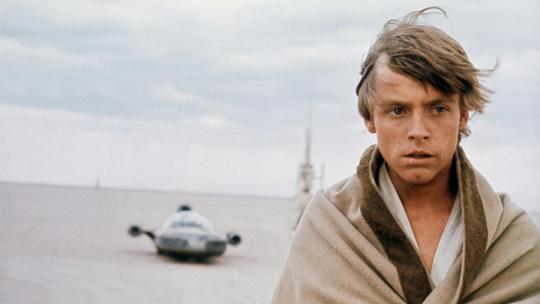
Luke Skywalker, last (hope?) of the Jedi.
The Prequel Trilogy (PT) was the first to create problems for this narrative. After all, the events of Revenge of the Sith take place 19 years before the events of A New Hope. I would hardly think that 20 years is enough time for the galaxy to forget about the Jedi. Even less so when you consider that the Clone Wars would have spread the Jedi throughout the galaxy, making them known even in the most distant Outer Rim worlds.
20 years ago there were thousands of Jedi. Now there are none. Revenge of the Sith tried to explain this through Order 66, just one in a long series of orders drilled into the clone army that instructed them to eliminate their Jedi commanders and every other Jedi they could get their hands on. The film shows us they were mercilessly efficient at that and very few Jedi managed to survive the betrayal, the most notable examples being Obi-Wan on Utapau and Yoda on Kashyyyk. But as the film also shows us, not all Jedi were killed by the clones, either on the battlefield or back at the Jedi Temple. Obi-Wan managed to get a message out warning any surviving Jedi of the fall of Coruscant and the clones’ betrayal, and instructing them to stay hidden until... whenever. There’s a very funny deleted scene from Episode III where the clones dress up as Jedi to trick Yoda and Obi-Wan with predictably bad results.
Anyway, as I was saying, no matter how efficient the clones might have been, it stands to reason that some Jedi other than Obi-Wan and Yoda would have survived the purge. Again, going with EU material, the Dark Times comic series show us as much as Darth Vader begins his quest to eliminate any and all surviving Jedi, and he’s very good at it. Any Jedi that might have survived that second purge where probably in hiding during the events of the OT, right?
Wrong. In Star Wars Rebels, Kanan notices that young Ezra is strong in the Force and undertakes the daunting task of training him. So now we have a Jedi Master and Padawan, fighting together with the Rebel Alliance, five years before the events of A New Hope. In fact, the events of season three of Star Wars Rebels take place as close as 2 BBY.
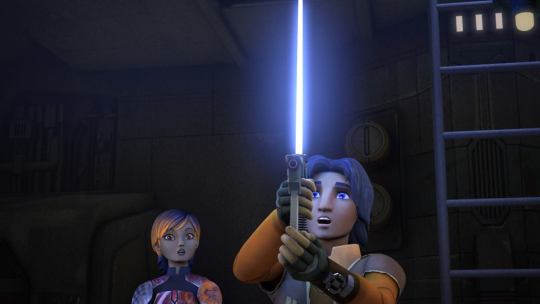
What?
It gets better. Joining them in their struggle in season two is none other than Anakin Skywalker’s former padawan, Ahsoka Tano, who’s also working with the Rebel Alliance! As if that weren’t enough, we also have the Inquisitors, an organization of Force-sensitive agents working for the Empire to hunt down Jedi. By episode 14 of season 2 I counted at least 3 Inquisitors and there are probably more if the “fifth brother” and “seventh sister” quotes are any indication.

Um, well...
There’s more. Darth Maul makes an appearance at some point in season two and definitely returns in season three. Kanan and Ezra travel to a Jedi Temple where they both receive guidance from Yoda himself. Holocrons pop up, and the Bendu monks get transformed into Bendu, a Force-sensitive individual who represents the center of the Force.
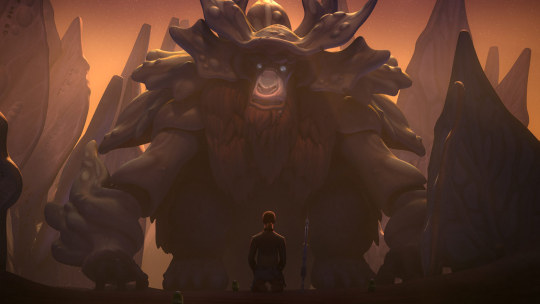
...
Where should I begin?
If it was hard for me (or anyone, really) to believe the galaxy had forgotten about the Jedi over the span of 20 years, you can imagine it’s even harder for me to believe they’d forgotten about them over the span of 2 years (and that’s if Rebels ends at 2 BBY, it could end at 0 BBY!). I suppose one could argue that the galaxy is a big place, and that even dozens of Force-powered individuals running around waving their lightsabers like mad might get unnoticed by the galaxy at large. I can see myself conceding this point. There could’ve been Jedi rebels spread throughout the galaxy waging their own personal little wars against the Empire, careful not to attract undue attention to themselves.
Unfortunately, Kanan and Ezra seem to do everything in their power to stay in the Empire’s spotlight. Furthermore, they��re irrevocably linked to the Rebel Alliance, to the point that Princess Leia Organa herself saw the pair wielding their lightsabers and using the Force! Such a tale would’ve certainly spread like wildfire throughout the rebel cells, reaching both the Core and the Outer Rim. The Rebel Alliance had found not one, not two, but three Jedi (so far) to rally around and bring the fight to the Empire... 5 years before they found Luke Skywalker and 9 years before the Jedi, um, returned? Revenge of the Jedi’s starting to sound awfully better now, isn’t it? Pity the Sith got there first.
To further compound the problem is the matter of Ezra’s training. At the rate this is going, he’ll end up having more training than Luke ever did in the OT. He’s had access to a Jedi Temple, two Jedi who’re around almost full-time (Ben died fairly soon and Luke cut short his training with Yoda on Dagobah), two holocrons, and there may be other things I’m not aware of yet. Perhaps Marvel intends to fill the gap of Luke’s training with novels and/or comics? My point is that Ezra seems to be turning too powerful too easily and Disney will have to pull off another Order 66-like stunt if they’re going to get rid of him, Kanan, and Ahsoka by the time Luke arrives.
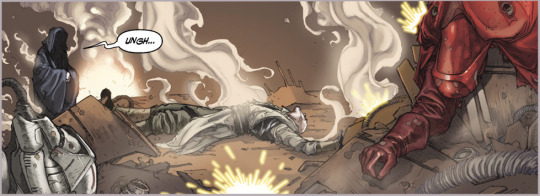
Will this be Kanan and Ezra’s fate?
We already had an episode in season one where Vader fought more eager, less experienced, versions of Kanan and Ezra and couldn’t (or wouldn’t) defeat them. I believe there’s a similar episode in season two with pretty much the same results. Do the creators intend to go The Force Unleashed route with a final showdown between the Emperor, Vader, Kanan, and Ezra, where Palpatine wipes the floor with the Jedi? The Inquisitors are useless after all. Will they instead go into hiding like their fellows? That would be quite the reversal given everything that’s happened on the show but it wouldn’t surprise me. Not anymore.
A galaxy without stakes
The struggle between the Rebel Alliance and the Empire is more than well documented, at least under EU material. Even if we’re talking canon sources, only recently we had Rogue One, a new Star Wars movie set around 0 BBY that tells the story of how the Rebels got their hands on the Death Star plans that Darth Vader is so keen on getting back in A New Hope.
Rogue One is, in essence, a war drama in the vein of the old World War II films I used to watch, like The Guns of Navarone or The Dirty Dozen, sharing more similarities with the former than the latter. It’s a film that attempts to show us the Alliance’s darker side and the lines they’re willing to cross to defeat the Empire, all the while driving the point that war is not a clean and clear-cut affair, with multiple rebel groups having different goals and methods to go about it, and civilians often getting caught in the crossfire. This movie does not shy away from death, having the largest body count since the Death Star blew up Alderaan in A New Hope. Okay, maybe not that high.

In Rogue One, war is hell.
Perhaps more so than A New Hope and Return of the Jedi, Rogue One succeeds at making the Empire feel powerful and menacing, to the point the Rebels actually consider giving up on the entire endeavour. Indeed, the Rebellion in Rogue One, while an organized force, is no match for the Empire, less so when the Death Star is put into play.
Far superior at showing this was The Empire Strikes Back during the Battle of Hoth, when the full force of the Empire was brought to bear on the Rebel base. A blockade around the planet was enforced by Star Destroyers while AT-ATs under the command of experienced General Veers led the ground assault against the Rebel forces. The Rebels put up a valiant effort but the outcome had been clear from the start: this battle was already lost; all they could do was delay the Imperial forces long enough for the evacuation to be completed. Even then, the evacuation was no simple affair. The Rebel transports could not evade nor outgun the Star Destroyers around the planet so they had to use Echo Base’s powerful ion cannons to disable them long enough to make the jump to lightspeed.
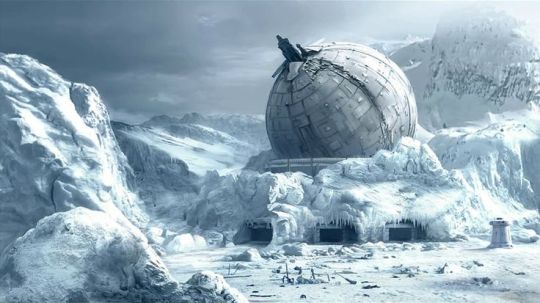
This is what it took to (temporarily) disable a Star Destroyer in Episode V.
Even our heroes are not safe from the Empire in Episode V. Luke learns a painful lesson when he hastens to rescue Han and Leia at Bespin, losing a hand in a duel with Vader that nearly cost him his life. Han is tortured, frozen in carbonite, and handed over to a bounty hunter. Later, in Return of the Jedi, a more seasoned Luke Skywalker pays the price of underestimating the dark side of the Force, something both Ben and Yoda warned him against. Had Vader not turned against the Emperor right there and then, Luke would’ve been toast. Of course, the Rebellion would’ve won the day nonetheless, right?
It is true that the depiction of the Imperial forces is uneven even among the movies of the OT. For the excellent Battle of Hoth we also have the (underwhelming) Battle of Endor, where the Empire’s forces are defeated by a small Rebel strike team working together with the primitive Ewoks. To be fair though, the size of the garrison on Endor is a lot smaller than the forces deployed during the Hoth battle and the terrain is a lot trickier and particularly well-suited for guerrilla tactics, where the advantage of numbers can be severely hampered. As a side note, there’s also a deleted scene from Return of the Jedi where we see Commander Jerjerrod’s conflict at being ordered by the Emperor to destroy the Endor moon, thereby killing friend and foe alike. No doubt Palpatine intended to use this to leverage Luke into submitting... or forcing him to use the dark side to strike at him. Quite the deviously cunning fellow Palpatine.

Well, that looks impressive.
Still, the sense that the movies and the EU convey is that the Empire, at the time of the OT, has a vast and fairly competent military, but suffers from corruption and internal power struggles, as does any large organization given enough power. Why would anyone expect anything less? The Grand Army of the Republic (GAR) was perhaps the most effective and efficient military at the time of the Clone Wars, comprised mostly, but not excusively, of highly-trained clones. I’m uncertain whether the clones’ rapid-aging is something that’s still canon (I somehow doubt it), but in any case Star Wars Rebels tells us that the Empire started phasing them out after the events of Episode III, replacing them with regular people, probably drafted from the many worlds of the Republic/Empire.
I’ve seen many people use this argument to explain away things like why the stormtroopers have such bad aim but that’s ridiculous. With the right training and the right tools/weapons, the Empire could still have the most powerful army in the galaxy, and guess what? They do have the right training and the right tools and weapons. Rex himself admits that the Empire did use the clones to train new recruits and pass down their knowledge. The Empire also obviously kept all the vehicles, weapons, and technology they used to fight the Separatists, acquired some new ones, and upgraded others.
There’s a popular, misquoted I believe, phrase that says, “There are no bad soldiers, only bad officers.” Possibly a re-interpretation of a quote attributed to Alexander the Great, “I am not afraid of an army of lions led by a sheep; I am afraid of an army of sheep led by a lion.” Regardless of the exact wording and of who said what, the point is clear: soldiers can only be (shown to be) as good as the person commanding them.
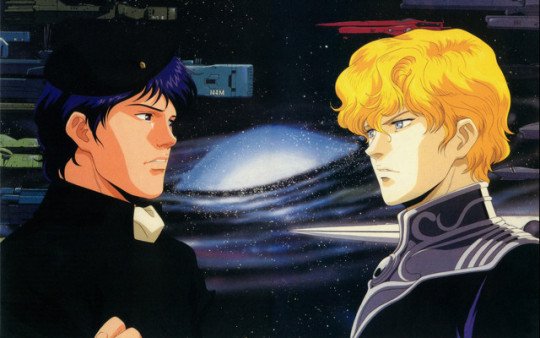
Yang vs Reinhard: Two sides of the same coin.
This is a point that the excellent Legend of the Galactic Heroes illustrates time and again. For all his clever strategies, Yang Wenli cannot help but follow the orders of the corrupt and self-serving, but duly elected, government of the Free Planets Alliance, with disastrous results. All Yang can do is stave off defeat and live to fight another day. On the other hand, the Empire’s own master strategist, Reinhard von Lohengramm, has carte blanche to deal with the Alliance as he sees fit, and surrounds himself with officers that have the talent and skills to defeat his enemy, regardless of their background.
Which is the case in Star Wars Rebels? Well, I guess it’s neither. The Imperial forces in Rebels are depicted as grossly incompetent, there’s no other way around this, hardly better than the battle droids from The Clone Wars. The stromtrooper effect is brought to bear in full force in this show, so much so that even the main characters are forced to comment on how bad the stormtroopers’ aim is. Officers fare no better, being made a mockery of, like missing a shot at point-blank range, and falling into the usual tropes of caricaturesque villainy, like having a fat Imperial officer steal a fruit from a vendor and daring him to stop him.

If I had a penny for every time I’ve seen this scene...
Rebels tries to revert this by introducing mildly competent characters like Agent Kallus, Tarkin, the Inquisitors, Vader, and even Thrawn in season three. Unfortunately, the more these characters are foiled (and they’re foiled a lot), the less effective they are at trying to reinforce the notion that the Empire is a force to be reckoned with. Halfway through season two, Kallus and the Inquisitors are more of a bad punchline than anything else. Tarkin and Vader are better off since their appearances have been few and far between. The only fear that the Empire seems to have sowed so far is among its own, as Imperial officers are made to account for their failure with their lives. It’s difficult to take the Empire seriously if it takes so little to foil them.
Only recently I watched an episode where Princess Leia tries to indirectly deliver ships to the Rebels. The plan is for Kanan and company to steal the freighters while Leia’s delivering supplies. The Imperial officer on the planet, in what shall hence be known as “that time that the Empire did something smart,” aware that Alderaanian ships have fallen into Rebel hands under similar circumstances, secures them with gravity locks and adds a pair of (old?) AT-ATs for further security. The Rebels are initially stumped and grimly reach the conclusion that, at best, they’ll be able to steal one of the freighters but not all three. However, as is the case with the show, they manage to steal all three. The gravity locks are easily disabled by Chopper working together with an escaped Imperial prisoner who just happened to build gravity locks while in captivity; the AT-ATs are easily destroyed by the Ghost (that’s the name of Hera’s ship by the way), while Kanan chops off their legs with his lightsaber; and the stormtroopers are their usual useless selves.

Guess Luke forgot that trick in Empire Strikes Back, and Dark Empire, and pretty much every other story ever.
The Empire’s ineptitude on its own is enough of a problem but there’s another that adds to it, and that’s the familiar trope of plot armor. Yes, our main characters have it, a lot of it. Our small band of freedom fighters can do no wrong or get seriously injured. They can easily defeat the toughest of enemies and they always get away with anything no matter what.
As an example, in that very same episode I mentioned above, at a certain moment a Hammerhead-class cruiser fires at the spot where the Princess, Kanan, and Ezra are standing still. My initial thought was, “How are they going to make it out of that? ‘cause that cruiser is bound to pack a punch.” The end result was nothing but a bit of smoke, a punch no more powerful than if a couple of stormtroopers had fired their blasters. The Hammerhead-class cruiser is not equipped with blasters but turbolaser cannons, and their discharge on ground troops should feel like artillery was raining down on you. However, this is far from the only example where the rules bend around our protagonists.
Perhaps the most egregious example though is the one I saw recently. I was watching episode 13 of season 2, “The Protector of Concord Dawn.” The Rebels are searching for new hyperspace routes not monitored by the Empire and they come upon the idea of using the hyperspace corridor through the Concord Dawn system. While the system has no apparent Imperial presence there is a Mandalorian colony on the planet Concord Dawn and so the Rebels try to negotiate safe passage with them. To make a long story short, the Mandalorians aren’t keen on the idea and shoot down a bunch of Rebel A-Wing fighters. Sabine’s the only one who makes it back to the fleet in one piece whereas Hera also makes the jump to lightspeed... with a half-destroyed A-Wing.

I mean, take a look at that. Are you seriously telling me an A-Wing managed the jump to lightspeed in that state and wasn’t torn apart in the process? Give me a break! And you know what the worst thing is, worse than that even? It was completely unnecessary! Indeed, having Hera captured by the Mandalorians would’ve been the perfect excuse for Kanan to mount a rescue op and return. Hera didn’t need to be safely tucked inside the belly of a Rebel frigate recuperating. But then Sabine wouldn’t have had a reason to seek revenge, would she? More on that later.
At the end of the day we have an Empire that’s less of a threat and more of a joke with every passing episode, and protagonists who can get away with anything with no consequences. A perfect example of this happens early on in the series when Sabine infiltrates an Imperial airfield to blow up its TIE fighter contingent. The reason behind this is unclear, or maybe that’s what I’d like to think, because otherwise the show would suggest she did it for the lolz and because she’s an artist. Right, an artist of death, there’s nothing disturbing about that.
Anyway, the stormtroopers are soon alerted to her presence and, in typical Rebels fashion, she toys with and taunts them until one stomtrooper notices something odd on the wing of a TIE that looks a lot like a bomb. Sabine promptly makes her escape while the bomb blows up on the stormtrooper’s face. I’m not kidding, look, here’s how close the stormtrooper’s face was to the bomb:
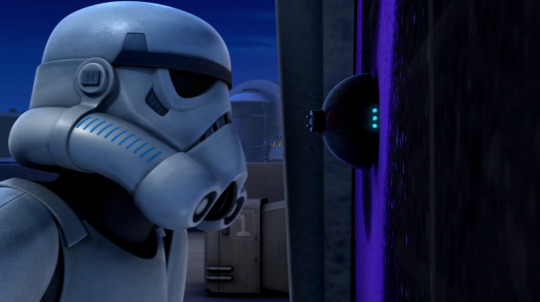
And he lived. Yup, he and his buddies lived to tell the tale in their next encounter with Sabine in the airfield where she again blows up the TIEs, thereby reassuring us viewers that Sabine’s actions are completely harmless and that the stormtroopers will live to get blown up again. Isn’t that funny? I’m guessing that showing the shockwave from the explosion chopping the stormtrooper’s head off in a kids’ show would’ve been too funny, right?
All of this, the fact that the Imperials are useless, that the Rebels are invulnerable, that actions have no consequences, it all adds up to one simple, inevitable, truth: there are no stakes in this galaxy. Sure, a rebel fighter will be blown up from time to time, but who cares, you never knew him anyway. But wait, a protagonist gets captured! So what? Getting him out is as straightforward and repetitive as going to Tosche Station to pick up some power converters. It’s no big deal, just send in the A-Team, they’ll extract him and blow up half the Empire while they’re at it. There’s a blockade around the planet where the Rebels are at. So what? The A-Team will blow stuff up and escape with no casualties. Who needs a planetary Ion Cannon?
But there are AT-ATs!
Made out of paper apparently.
Inquisitors!
They sure don’t live up to the name.
Darth Vader himself!
One appearance so far and he fails to capture or seriously cripple the Rebels in any way.
Um, Thrawn?
Look, I’m sure the creators thought that they were upping the stakes every time they introduced a new villain but I would question whether there were any to begin with. Like I said before, are we going to go all the way up to the Emperor to finally get things done? For all its faults, the Empire wasn’t that useles in the OT.
In a galaxy without stakes there’s little reason to care about its characters or their struggle and eventually you have to wonder, why is there even a struggle at all? When the show makes me ponder why the Rebellion hasn’t beaten the Empire already you know there’s something wrong somewhere.
What the Rebellion stands for
There’s a traditional narrative that the Rebel Alliance are noble idealists who rise up against the tyranny of the Galactic Empire to deliver peace and freedom to all peoples throughout the galaxy. That’s no secret, the opening crawls of the movies reinforce this by describing the Empire as ‘evil’ and having ‘sinister’ agents, and that ‘dreaded’ Imperial Starfleet, whereas the Rebels are ‘freedom fighters,’ and they have a Princess. Nobody doubts that the Empire are the bad guys here and the Rebel Alliance are the good guys.
Recently, Rogue One attempted to tint that narrative with shades of grey, at least on the part of the Rebels. Yes, the Rebels had spies, and assassins, and bombers, and they did terrible things in the name of the greater good. Our own history tells us that sometimes even the good guys can take extreme measures to end a conflict. Just consider the bombings of Hiroshima and Nagasaki during World War II. The U.S. used a superweapon to raze two cities to force the Japanese Empire to surrender. There was a reason behind the madness though. Oblivious to the development of the atomic bombs, the Allies had been working on a plan, codenamed Operation Downfall, for the invasion of Japan. Projected casualties for this plan were high and some estimates even reached the millions of fatalities on each side.
Depending on how you look at it, where you stand, war can be seen as an abstract, white vs black, a fight between the forces of good and evil. But from the battlefield, things aren’t always so clear cut, it’s not always easy to tell what’s the right thing to do and what’s the wrong thing to do.

Welcome to the harsh reality of war: she’ll be fine.
As I was watching “The Protector of Concord Dawn,” I was struck by Sabine’s anger at how the Mandalorians cut the Rebels to pieces. Hera almost dying now convinces Sabine that the Protectors are bad, what hardens her resolve to seeing them killed. Maybe it’s not said in so many words but the subtext (to be honest, there isn’t much sub) is there. After all, how dare they shoot at Hera when all the Rebels wanted was to negotiate for safe passage... and bully the Mandalorians into submission if that didn’t work. In fact, if memory serves, that was the original plan proposed by Commander Sato, a show of force meant to say, “you mess with the bull, you get the horns.”
Even Kanan, who initially suggests to try the diplomatic approach, soon changes his tune once the Protectors make it clear they won’t help the Rebels. But let’s explain exactly what the Protectors’ role is, shall we? The Protectors of Concord Dawn are a small group of Mandalorian warriors, led by Fenn Rau, who helped train clone troopers during the Clone Wars and even fought with the Republic in a few battles. Disillusioned by the result of the war, Fenn Rau has opted to bend his knee to the Empire, what I guess amounts to making sure no Rebel ship passes through Concord Dawn unscathed. The Protectors don’t have many resources, maybe as much as two dozen fighters, so it’s doubtful the Empire expects a lot of results from them. This means the Protectors are no direct threat to the Rebels unless the latter insist on using the Concord Dawn hyperspace corridor, which they do. As a result, the Rebels blow up most of the Mandalorian starfighters and kidnap Fenn Rau who, out of the blue, decides not to pursue the Rebels nor report their presence to the Empire. That doesn’t get him out of cuffs though.

Using blackmail to get things done. The Empire would be proud.
How was the Rebellion any better than the Empire here? Aren’t they abusing their power as they accuse the Empire of doing? The fact that Sabine was so eager for the Mandalorians’ blood is equally disturbing. What does she think happens to the stormtroopers they shoot or the fighters they destroy? The stormtroopers aren’t droids, the TIEs aren’t unmanned. These are people, good and bad, who are serving the Empire for a variety of reasons. But Rebels isn’t keen on exploring this, is it? Worse, it seems the writers are oblivious to it. Perhaps they expect us to go along with everything the Rebels do just because they’re the good guys?
When Anakin Force choked Poggle the Lesser in The Clone Wars it didn’t make his action any less bad because he was fighting for the good guys and we knew it. Everything in that scene suggested he was doing something bad, that he was drawing closer to the dark side. When Cassian shoots that man at the beginning of Rogue One you know he’s doing something bad, everything in that scene plays to that effect. Cassian’s momentarily disturbed by it and later brings up the subject of all the terrible things he’s done in the name of the Rebellion. At least he acknowledges it, Rebels doesn’t even try to ponder the matter. Kanan and company don’t even stop to consider that perhaps it wasn’t the right thing to do. That perhaps they could’ve left the Protectors alone, that perhaps they could have tried to recruit them at some other time and continue to look for another hyperspace route. What happens the next time the Rebels ask for something and they’re told no, do they take it by force regardless?
These are questions that should naturally occur to any of the protagonists but, sadly, don’t. If they did, it would certainly elevate the show’s value in my eyes. To clarify, It’s not the fact that the Rebels do questionable things that I find disturbing, what I find disturbing is the fact that they don’t find anything questionable about them and that we, the viewers, are not meant to regard them in such a light. They’re the Rebels and their cause is just or, in other words, the ends justify the means.
To be fair, this was just one episode and it may very well be the only one. Turning out script after script for each new episode is probably no mean feat, and some episodes are bound to be tighter than others, but it had me asking all the wrong questions about Star Wars Rebels.
Conclusion
Having written all of this one might be led to believe that Star Wars Rebels is a terrible show, a stain on the popular franchise built by George Lucas and now owned by Disney. But like I said at the beginning of this post, it’s not. Rebels is far from the only show where its protagonists have plot-armour, or the villains are incompetent. It’s not the first show that suffers from narrative issues and it certainly won’t be the last. It’s certainly not the first one to mess with Star Wars continuity, oh no, Lucas was doing a fine job at that before Disney, with as recent an example as The Clone Wars.
What Star Wars Rebels is, is lazy. Its depiction of the fight between good and evil is one we’ve seen countless times before, and one we’ll see countless times hence. It’s easy to show the Imperials as incompetent bullies and the Rebels as invincible do-gooders, and it gets tiresome to watch the same tropes repeat themselves over and over again. One can go as far as saying it insults the viewer’s intelligence when the good guys’ actions are never challenged, even when they may be morally (or otherwise) reprehensible, or when the laws of the universe are knowingly ignored, damaging the narrative for the sake of drama.
There are no consequences to speak of that invite discussion, no stakes to make us care about the protagonists’ struggle. And it’s important that we care, if not for them, at least for the fledgling Rebel Alliance in their struggle against the mighty Empire. But if our protagonists don’t take the Empire seriously, why should we? Why should I? Might as well be just another day at Tosche Station picking up power converters.
6 notes
·
View notes
Text
WEDNESDAY BRIEFING: ALABAMA DRAMA DING-DONG
Is it the turning of the Trump tide, or simply a victory for decency? Roy Moore, the tainted Republican candidate thumpingly endorsed
by the president, has lost his run for the Senate in Alabama. Jubilation among Democrats at the victory overnight of their candidate, Doug Jones, has been accompanied by sighs of relief among senior Republicans who feared the spectacle of a man accused of pursuing underaged girls being elected to represent their party in Congress.
Results showed Jones had won the seat with 49.9% of votes against Moore’s 48.4%. In his victory speech, Jones declared the campaign had been about “dignity, respect and the rule of law”.
Moore declined to concede as he appeared before supporters in Montgomery, the state capital. His campaign chairman raised the prospect of a recount. Moore complained he had been “painted in an unfavourable and unfaithful light” during the race. Donald Trump, though, congratulated Jones on a “hard fought victory” in a tweet that was uncharacteristically tame. “The Republicans will have another shot at this seat in a very short period of time,” said the president. “It never ends!”
Guardian US columnist Richard Wolffe says Moore’s defeat reveals the limitation of Trump-style politics: “No accusation of fake news that can cover the tracks of the disastrous results for the president. This wasn’t a marginal contest in some familiar swing state. We’re talking about Alabama, one of the most Republican states in the union … If Trumpism has any future, any constituency moving forward, it should be thriving here.”
(adsbygoogle = window.adsbygoogle || []).push({});
‘Davis-proofing’ the divorce – EU lawmakers are moving to personally censure David Davis after he talked down last week’s breakthrough agreement as not legally binding. In an unusual move, the European parliament’s main parties have announced an amendment to their Brexit resolution, on which MEPs will vote today, condemning the Brexit secretary personally for damaging trust. Michel Barnier, the EU’s chief negotiator, has warned that the UK’s divorce deal with the EU depends on the British government sticking to the deal made last week on Ireland, citizens’ rights and the financial settlement – “we will not accept any backtracking”.
Meanwhile, rebel Conservative MPs are backing Dominic Grieve, who will press ahead today with plans to force the government to guarantee MPs a vote on any final Brexit deal. And it is feared that hundreds of thousands of EU citizens could miss out on their right to “settled status” in Britain post-Brexit. The Migration Observatory at Oxford says difficulties in providing a history of living in the UK and meeting other requirements could complicate numerous cases.
(adsbygoogle = window.adsbygoogle || []).push({});
Sexual harassment in Bollywood – Women in India’s film industry have shared their stories of sexual assault and harassment with the Guardian. “The casting couch is one of Indian cinema’s most open secrets,” says Anna MM Vetticad, journalist and author. This year, in Kerala state, a male actor known as Dileep was arrested for allegedly orchestrating the kidnapping and sexual assault of a prominent female actor. The case led to formation of a women’s film collective aimed at quashing mistreatment. “It is an industry where actors have to wear any kind of dress or do intimate scenes,” says the female actor Padmapriya, winner of a National Film award. “And people assume, if you’re up for doing that, then what’s the big deal?”
Night out ends in tragedy – A Norfolk man has been found dead after walking off into a sub-zero night wearing only a T-shirt and jeans. Ian Tang was last seen by friends at 2.30am on Sunday morning leaving the KA club in the town of North Walsham. A motorist later spotted him walking along a road between 5.45am and 6am. Tang’s body was found yesterday, close to the village of Swafield, near North Walsham, after an extensive search. The death is not being treated as suspicious but police say they are trying to piece together the exact circumstances.
More muscles the better – Women mostly prefer a strong-looking man even if they say they don’t, according to researchers. A panel of 160 women were shown photographs of male bodies, with the head blanked out, and asked to rate them for attractiveness. “Our data couldn’t find even a single woman that preferred weaker or feminine male bodies,” said Aaron Sell, a senior lecturer at Griffith University in Australia. The men were also given a strength test, and it was by far the strongest predictor of attractiveness, explaining a 70% of the difference in scores. Being tall added a few points; being overweight deducted a few. “Our results suggest that even if you’re a bit overweight, looking strong can buffer that. Basically, being a strong, fat guy is OK, which I think would bring comfort to many.”
‘She came out crying’ – In a UK medical first, a baby girl has survived after being born with her heart outside her body. Three weeks after her early delivery by caesarean, Vanellope Hope Wilkins has undergone three delicate operations at Glenfield Hospital, Leicester, to correct the condition, known as ectopia cordis, and move her heart back inside her chest.
Her parents, Naomi Findlay, 31, and Dean Wilkins, 43, have told of their relief after being told during the pregnancy that Vanellope’s hopes were slim. “Twenty minutes went by [after the delivery] and she was still shouting her head off – it made us so joyful and teary,” said Wilkins. Branko Mimic, lead surgeon at the East Midlands Congenital Heart Centre, says Vanellope still has a long road ahead.
(adsbygoogle = window.adsbygoogle || []).push({});
Lunchtime read: What the Force did after awakening
The verdict is out on Star Wars: The Last Jedi. “An explosive thrill-ride of galactic proportions,” writes Guardian film critic Peter Bradshaw, as Rey and Kylo Ren cut, parry and slash onwards to destiny, while a grizzled Luke Skywalker re-emerges from the shadows.
“The Last Jedi gives you an explosive sugar rush of spectacle. It’s a film that buzzes with belief in itself and its own mythic universe – a euphoric certainty that I think no other movie franchise has. And there is no provisional hesitation or energy dip of the sort that might have been expected between episodes seven and nine.”
Sport
José Mourinho has questioned whether Manchester City’s players have the same “education” as their Manchester United counterparts and insisted the Premier League leaders were to blame for the brawl at Old Trafford that has left the clubs facing the possibility of disciplinary action. Some hope has been restored for Crystal Palace, meanwhile, after they plucked an improbable win from the jaws of defeat against Watford.
Tyson Fury has set his sights on a title fight with Anthony Joshua after being cleared to box again following a deal with UK Anti-Doping. And in Ashes news, Joe Root has urged his players to forget about England’s wretched past at the Waca and jolt their flatlining defence back into life in the third Test after Trevor Bayliss issued the squad with final warnings over their off-field behaviour.
(adsbygoogle = window.adsbygoogle || []).push({});
Business
US stock futures, Treasury yields and the dollar have all fallen overnight in Asian trading, while Asian shares edged up as crude oil futures took back lost ground. South Korea says it may tax capital gains from trading in Bitcoin and its ilk, while Australia’s central bank chief has warned of a “speculative mania” around cryptocurrencies.
Sterling has been trading at $1.333 and €1.133 overnight.
The papers
The premiere of – and verdicts on – Star Wars: The Last Jedi make most fronts, but that aside it’s a mixed bag of leading stories.
The Guardian splashes on an exclusive about corporate spies infiltrating activist groups. The extraordinary story of the baby who survived after being born with her heart outside her body makes the front of the Sun and the Mirror. There’s a dash of Brexit, with the Express reporting a poll boost for Theresa May following last week’s deal. The Times claims European commission president Jean-Claude Juncker has been “dragged into” a wiretapping investigation in Luxembourg, where he was formerly prime minister.
Abuse on social media aimed at Tory MPs during the election campaign is the Daily Mail lead (a broader take on that story is here), while the i follows up the prime minister’s column in yesterday’s Guardian on the importance of tackling climate change. Meanwhile, the Telegraph warns that a gas shortage could push up fuel bills. The Financial Times thinks Fox and Disney are close to a deal. Metro leads on a court hearing for a Tory aide charged with raping a woman in the Houses of Parliament.
READ MORE ON:
(adsbygoogle = window.adsbygoogle || []).push({});
from Blogger http://ift.tt/2Ayyp3Z via IFTTT
0 notes